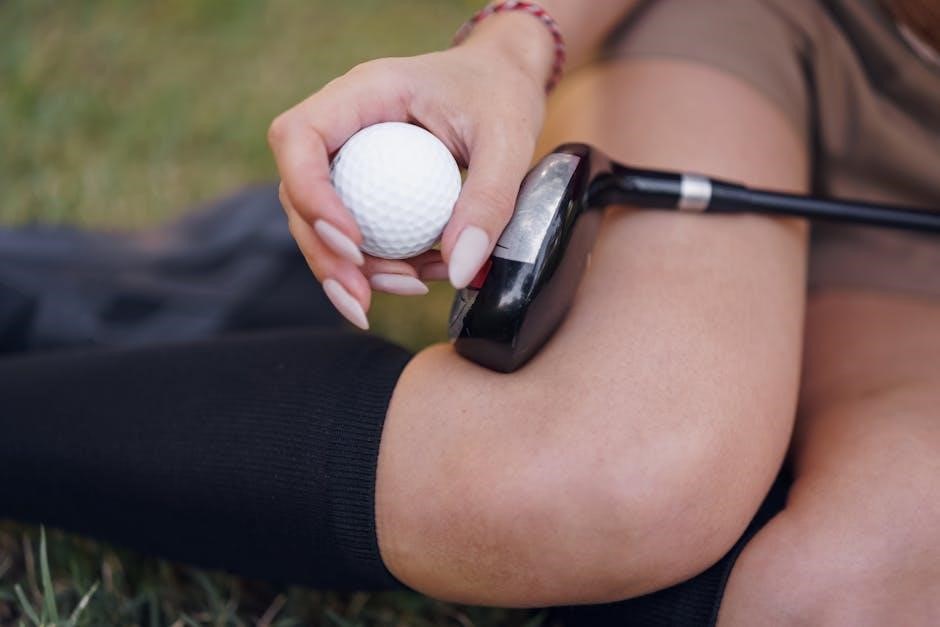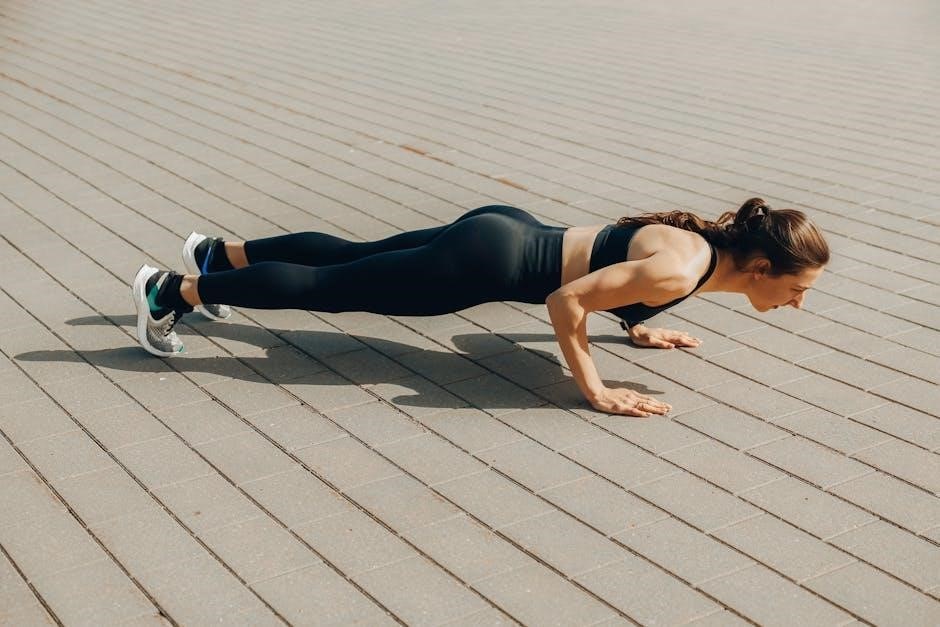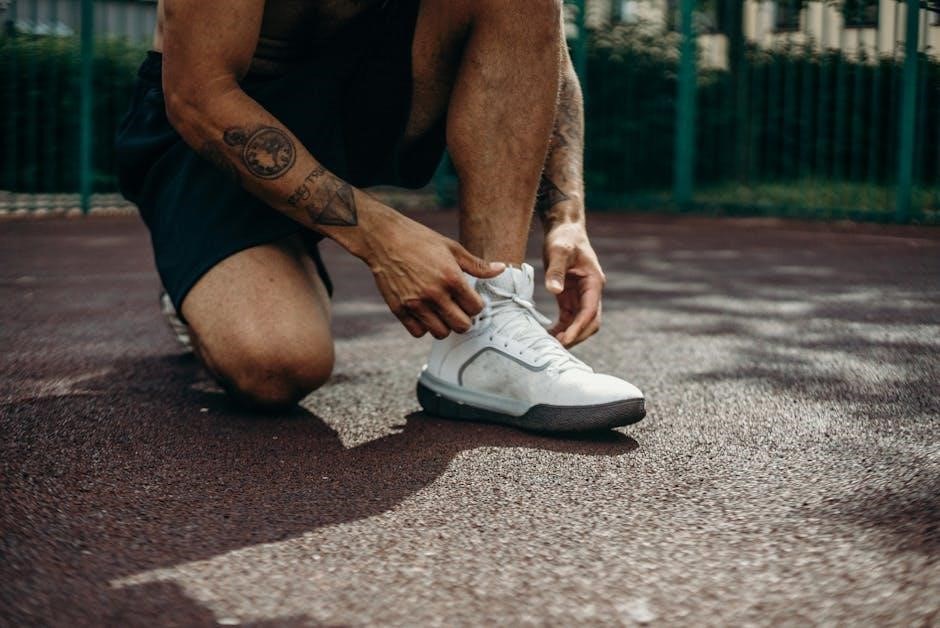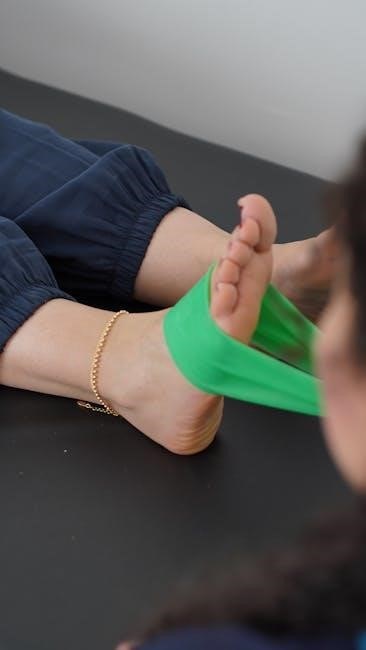Total knee replacement is a life-changing procedure that restores mobility and alleviates pain. This guide provides essential exercises and care tips to support recovery and regain strength effectively.

Benefits of Exercises
Exercises play a crucial role in recovery after total knee replacement, improving mobility, strength, and flexibility. They help restore movement, reduce pain, and prevent complications like blood clots. Regular exercises enhance circulation, promoting healing and reducing swelling. Strengthening muscles supports the new knee, improving balance and stability. Consistent exercise routines also boost confidence and overall well-being, enabling patients to return to daily activities sooner. A structured exercise plan, tailored to different recovery phases, ensures gradual progress and long-term success. Staying active fosters independence and helps maintain a healthy lifestyle post-surgery.

Preparing for Surgery
Preparing for knee replacement involves creating a safe environment, arranging post-surgery support, and strengthening muscles through prehabilitation exercises to ensure a smooth recovery process.
3.1 Pre-Surgery Checklist
Ensure a smooth preparation process with a detailed pre-surgery checklist. Arrange transportation and post-surgery support. Complete any prescribed prehabilitation exercises to strengthen muscles. Review and manage medications with your doctor. Set up a safe home environment, removing tripping hazards and stocking recovery supplies. Attend physical therapy sessions if recommended. Plan meals and freeze them for post-surgery convenience. Follow your surgeon’s instructions for fasting and preparing for the procedure. Stay informed about the surgery and recovery process to reduce anxiety. Proper preparation ensures a successful surgery and recovery journey.
3.2 Setting Up Home Environment
Creating a safe and comfortable home environment is crucial for recovery. Clear tripping hazards like rugs and clutter. Set up a recovery area with a firm chair, pillows, and a side table. Ensure the bathroom is equipped with grab bars and a shower chair for safety. Place frequently used items, such as medications and snacks, within easy reach. Consider using assistive devices like a reacher or walker. Store ice packs and compression wraps nearby. Plan meal prep or stock frozen meals for convenience. A well-prepared home reduces stress and supports a smooth recovery process.
Immediate Post-Surgery Exercises
Immediate post-surgery exercises promote circulation, reduce swelling, and maintain joint mobility. Gentle movements like ankle pumps and leg lifts are essential for early recovery and comfort.
4.1 Ankle Pumps
Ankle pumps are simple, effective exercises to improve circulation and reduce swelling after knee surgery. To perform, slowly point toes upward and then downward, repeating 10-15 times. This motion helps prevent blood clots and promotes healing. Start with 3-4 sets daily, increasing as comfort allows. Elevate the leg above heart level during exercises to enhance blood flow. Gentle and non-stressful, ankle pumps are a cornerstone of early recovery, aiding in restoring mobility and strength to the lower extremities after total knee replacement.
4.2 Quadriceps Sets
Quadriceps sets are essential for strengthening the muscles around the knee after surgery. To perform, tighten the thigh muscles by pressing the back of the knee into the surface. Hold for 5 seconds, then relax. Repeat 10-15 times per session, 3-4 times daily. This exercise helps restore muscle tone, improve circulation, and enhance knee stability. Start gently and gradually increase repetitions as strength improves. Consistency is key to rebuilding muscle support and ensuring proper recovery. This foundational exercise lays the groundwork for more advanced movements in later recovery phases.
4.3 Heel Slides
Heel slides are a gentle exercise to improve knee flexibility and range of motion. Lie flat or sit with legs extended. Slowly slide one heel toward your buttocks, bending the knee as far as comfortable. Hold for 5 seconds, then slide back to the starting position. Repeat 10-15 times per leg, 2-3 times daily. This exercise helps reduce stiffness, promotes circulation, and gradually increases knee mobility. Use a towel under the heel for easier sliding if needed. Perform smoothly without forcing the knee beyond a painful range to avoid discomfort or injury.

Intermediate Phase Exercises
This phase focuses on strengthening muscles and improving mobility. Exercises like straight leg raises and step-ups help restore balance and prepare for more advanced activities.
5.1 Straight Leg Raises
Straight leg raises are essential for strengthening the quadriceps and hip flexors without putting stress on the knee joint. To perform, lie on your back with the unaffected leg bent and the surgical leg straight. Tighten the muscles in the back of your thigh, then slowly lift the straight leg to the height of the bent knee. Hold for 5 seconds before lowering. Repeat 10-15 times per session. This exercise improves muscle strength, enhances joint stability, and promotes proper gait mechanics. It’s a cornerstone of the intermediate phase, helping patients regain functional mobility safely and effectively.
5.2 Wall Slides
Wall slides are an effective exercise for improving knee flexion and strengthening the surrounding muscles. Stand with your back against a wall and feet about 12 inches away. Slowly slide down the wall, bending your knees to a 45-degree angle, while keeping your back in contact with the wall; Hold for 10 seconds, then slide back up. Repeat 10-12 times. This exercise enhances knee mobility, strengthens the quadriceps and hamstrings, and promotes proper movement patterns. It’s ideal for the intermediate phase, helping patients gradually increase their range of motion and build confidence in their knee’s stability and function.
5.3 Step-Ups
Step-ups are a functional exercise targeting the quadriceps, hamstrings, and hip muscles, improving strength and balance. Stand in front of a low step or sturdy platform (4-6 inches high). Step up with one leg, bringing the other foot to meet it, then step down carefully. Perform 10-12 repetitions on each leg. This exercise mimics daily activities like climbing stairs and enhances knee stability. Proper form is crucial to avoid strain. Start with a low step and gradually increase height as strength improves. Step-ups are excellent for rebuilding functional mobility and confidence in the intermediate recovery phase.

Advanced Phase Exercises
Advanced phase exercises focus on enhancing strength and mobility, preparing the knee for high-impact activities, and restoring normal function for daily activities effectively.
6.1 Knee Extensions
Knee extensions are a key advanced exercise to restore strength and mobility. Sit or stand, then slowly straighten the knee as far as possible without pain. Hold for 5 seconds, then lower. Repeat 10-15 times in 2-3 sets; This strengthens the quadriceps and improves range of motion. Perform with or without resistance, like a light weight or band. Consistency helps regain full knee function and prepares for daily activities and more strenuous movements. Proper form ensures effectiveness and prevents strain.
6.2 Balance Exercises
Balance exercises are crucial for stability and coordination after knee replacement. Start with single-leg stands, holding onto a chair for support. Progress to heel-to-toe walking and wobble board exercises. These activities improve proprioception and reduce fall risk. Practice daily, gradually increasing difficulty as confidence grows. Balance training enhances overall mobility and ensures safer movement during daily activities. Consistency in these exercises aids in achieving a full recovery and regaining independence.
6.3 Strengthening Exercises
Strengthening exercises are essential for restoring knee function and muscle power post-surgery. Focus on straight leg raises, mini squats, and step-ups to target key muscle groups. Straight leg raises help rebuild quadriceps strength without stressing the knee joint. Mini squats improve overall lower limb strength while maintaining proper alignment. Step-ups enhance functional mobility and balance. Perform these exercises with controlled movements, gradually increasing resistance as strength improves. Consistency is key to achieving long-term mobility and reducing the risk of future injuries. Always consult with a physical therapist to tailor exercises to your specific recovery needs and progression.

Post-Operative Care
Proper post-operative care ensures a smooth recovery. Monitor for infection, manage pain, and follow rehabilitation plans. Elevate legs, use ice, and adhere to medication schedules for optimal healing.
7.1 Pain Management
Pain management is crucial for a comfortable recovery after total knee replacement. Follow prescribed medication schedules and combine with techniques like icing and elevating the leg. Gentle exercises, as recommended, can reduce stiffness without overexertion. Breathing exercises and relaxation methods also help alleviate discomfort. Avoid over-reliance on painkillers; balance rest with gradual movement. Monitor pain levels and adjust strategies as needed. Consult your healthcare provider if pain persists or worsens. Consistency in therapy and adherence to post-operative care guidelines ensure effective pain control and support the healing process.
7.2 Wound Care
Proper wound care is essential after total knee replacement to prevent infection and promote healing. Keep the surgical site clean and dry, following your healthcare provider’s instructions. Use prescribed dressings and avoid submerging the wound in water until fully healed. Monitor for signs of infection, such as redness, swelling, or increased pain. Report any unusual symptoms to your doctor promptly. Adhere to post-operative guidelines, including antibiotic use if prescribed. Elevate your leg to reduce swelling and ensure proper blood flow. Maintain good hygiene practices to support recovery and minimize complications.
7.3 Preventing Complications
Preventing complications after total knee replacement requires careful monitoring and adherence to post-operative guidelines. Monitor for signs of blood clots, such as swelling or pain in the calf, and report them immediately. Use anticoagulants as prescribed to reduce clotting risks. Avoid smoking and maintain a healthy weight to promote healing. Follow infection prevention measures, such as keeping the wound clean and attending follow-up appointments. Adhere to your physical therapy routine to avoid stiffness and ensure proper joint mobility. Report any unusual symptoms, such as fever or redness around the wound, to your healthcare provider promptly.
Role of Physical Therapy
Physical therapy plays a crucial role in recovery after total knee replacement, helping restore strength, mobility, and function. A tailored program addresses flexibility, balance, and muscle strengthening. Therapists guide patients through exercises, ensuring proper technique and progression. Early mobilization prevents stiffness, while advanced phases focus on returning to daily activities. Consistency in therapy accelerates healing and reduces complications. Regular sessions, combined with home exercises, promote long-term joint health and independence. A well-structured physical therapy program is essential for achieving optimal outcomes and regaining a active lifestyle after surgery.

Importance of Consistency
Consistency in performing prescribed exercises is vital for optimal recovery after total knee replacement. Regular practice helps strengthen muscles, improve joint mobility, and prevent stiffness. Patients who adhere to their exercise routines often experience faster healing and better long-term outcomes. Inconsistent efforts can lead to prolonged recovery, increased pain, and reduced functionality. A commitment to daily exercises, even when challenging, ensures continuous progress and supports overall joint health. Staying consistent also helps prevent complications and fosters confidence, enabling patients to return to their normal activities more effectively. It is a cornerstone of successful rehabilitation and long-term success.

Nutrition and Recovery
Nutrition plays a crucial role in recovery after total knee replacement. A balanced diet rich in protein, vitamins, and minerals supports muscle repair and tissue healing. Foods high in omega-3 fatty acids, such as fish and nuts, reduce inflammation. Calcium and vitamin D are essential for bone health, while iron and zinc promote wound healing. Staying hydrated is vital for joint health and overall recovery. Avoid processed foods and excessive sugar to prevent inflammation. A well-planned diet, combined with regular exercise, accelerates recovery, enhances strength, and ensures optimal outcomes. Proper nutrition is a cornerstone of a successful rehabilitation journey.

Common Mistakes to Avoid
Avoiding common mistakes is crucial for a smooth recovery after knee replacement. Overexertion is a frequent error, as pushing too hard can lead to injury or prolonged recovery. Ignoring pain signals is another mistake; persistent discomfort should be reported to your healthcare provider. Improper exercise techniques can cause further damage, so adherence to prescribed routines is essential. Inadequate rest and failing to attend physical therapy sessions can hinder progress. Additionally, neglecting dietary advice or smoking can impede healing. Following post-operative guidelines and maintaining open communication with your healthcare team ensures a safer and more effective recovery journey.
Monitoring Progress
Monitoring progress after knee replacement is vital to ensure a successful recovery. Track your ability to perform exercises, improvements in mobility, and reduction in pain. Regular physical therapy check-ups help assess strength and range of motion. Keep a journal to document daily achievements and challenges. Adjust your routine based on feedback from healthcare providers. Celebrate small milestones, like walking without assistance or climbing stairs. Consistent progress indicates healing is on track, while plateaus or setbacks may require adjustments. Open communication with your recovery team ensures personalized guidance and supports long-term success. Stay motivated and focused on your goals for optimal outcomes.
Returning to Normal Activities
Returning to normal activities after knee replacement requires patience and gradual progression. Most patients can resume daily tasks like walking, driving, and light household chores within weeks. Avoid high-impact activities initially to protect the new knee. Strengthening exercises and physical therapy help rebuild muscle support. Light sports, such as swimming or cycling, may be reintroduced under medical guidance. Focus on activities that promote joint health without excessive strain. Balancing activity with rest ensures proper healing and long-term function. Always follow your surgeon’s recommendations to safely transition back to your normal lifestyle and hobbies.
FAQs
When can I start exercising after surgery? Begin gentle exercises immediately, as directed by your healthcare provider. Early movement promotes healing and prevents stiffness.
What if exercises cause pain? Mild discomfort is normal, but stop if pain is severe. Consult your physical therapist to adjust the routine.
How long until I can drive? Most patients can drive within 4-6 weeks, once they can bend and move safely.
Can I resume sports? Avoid high-impact sports like running. Low-impact activities like swimming or cycling are usually allowed after full recovery.
How long does full recovery take? Recovery varies, but most patients regain strength and mobility within 6-12 months. Consistency in exercises is key.
What if I experience swelling? Elevate your leg and apply ice to reduce swelling. If persistent, contact your doctor.
Can I climb stairs? Yes, with assistance initially. Practice step-ups as part of your exercise routine.
How often should I exercise? Follow your prescribed routine, typically 2-3 times daily, to ensure proper healing and strength.
These answers address common concerns and help guide patients through their recovery journey.
Consistency in following a structured exercise program is crucial for optimal recovery after total knee replacement. By adhering to prescribed exercises, patients can restore mobility, strength, and flexibility. Physical therapy plays a vital role, and utilizing resources like PDF guides ensures a comprehensive approach. Recovery is gradual, but commitment to the process leads to successful outcomes. Stay positive, follow medical advice, and embrace the journey toward regaining independence and enjoying an active lifestyle.

Additional Resources
Downloadable PDF guides and support groups offer valuable information and community support for patients recovering from total knee replacement surgery, enhancing the recovery journey;
16.1 PDF Guides
Downloadable PDF guides provide comprehensive information on total knee replacement exercises, recovery tips, and post-operative care. These resources, often created by healthcare providers, include detailed exercise routines, recovery checklists, and nutritional advice. Many guides are designed to complement physical therapy programs, offering visual aids and step-by-step instructions for exercises like ankle pumps and quadriceps sets. Patients can access these guides through hospital websites or rehabilitation centers. They serve as valuable tools for tracking progress and ensuring a smooth recovery journey, catering to both patients and their support networks for better understanding and adherence to rehabilitation plans.
16.2 Support Groups
Support groups play a vital role in the recovery journey after total knee replacement surgery. These groups, whether online or in-person, provide a platform for patients to share experiences, challenges, and tips for rehabilitation. Many participants find comfort in connecting with others who have undergone similar procedures, fostering a sense of community and understanding. Support groups often discuss topics like exercise routines, pain management, and emotional well-being. They also offer practical advice, such as modifying homes for recovery or dealing with common post-surgery frustrations. Engaging with these groups can enhance motivation, reduce isolation, and promote a smoother transition back to normal activities.
References
For further reading and detailed exercise routines, refer to the following resources:
Allina Health provides comprehensive guides on knee replacement exercises and recovery.
The East Sussex Healthcare website offers detailed rehabilitation programs and patient testimonials.
Additional resources, such as the Total Knee Replacement Exercise Guide, offer step-by-step instructions and visual aids.
Consult your healthcare provider for personalized recommendations and verified sources tailored to your recovery needs.
Final Thoughts
Consistency and patience are key to a successful recovery after total knee replacement. The exercises outlined in this guide are designed to restore strength, mobility, and flexibility. By following the structured phases and seeking support from healthcare professionals, patients can achieve optimal outcomes. Remember, recovery is a journey, and adhering to the recommended routines will lead to long-term benefits. Stay committed, and you’ll regain independence and confidence in your daily activities. For additional guidance, refer to the resources provided in the references section.
